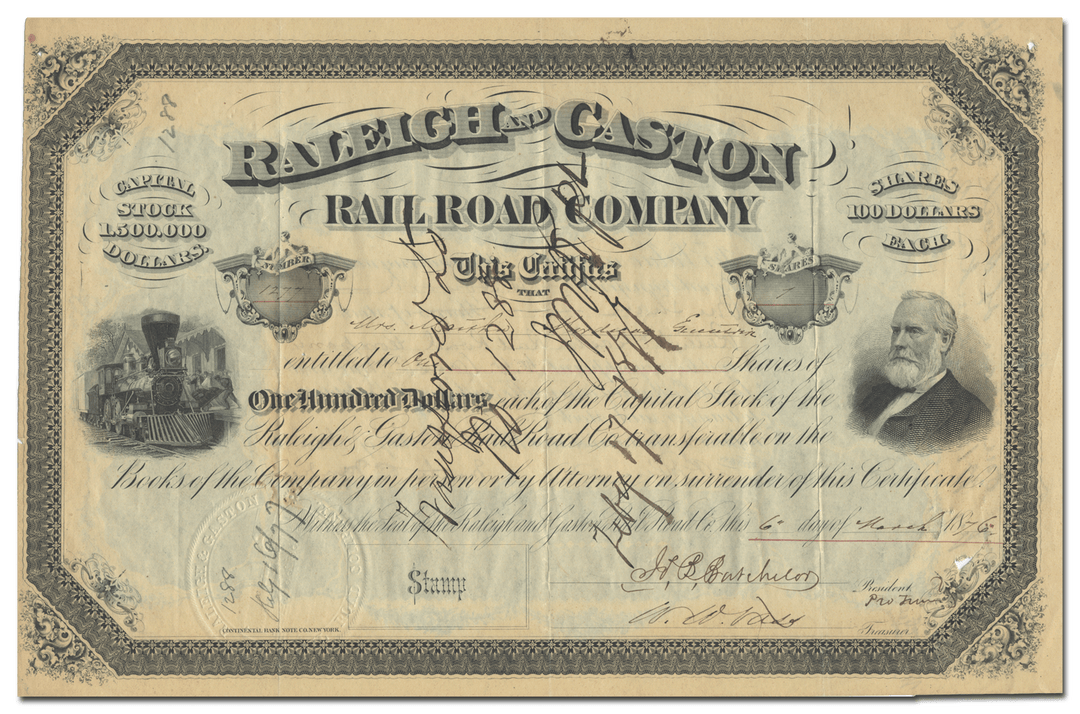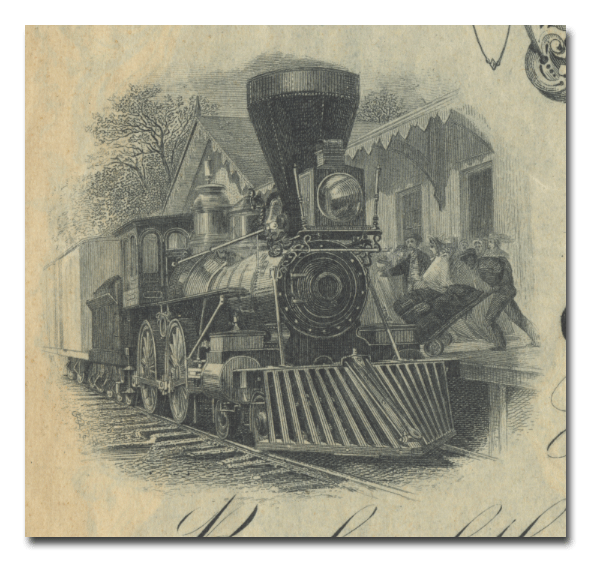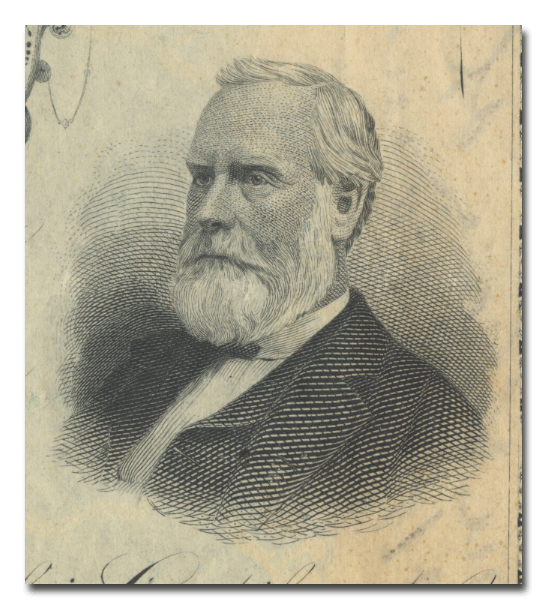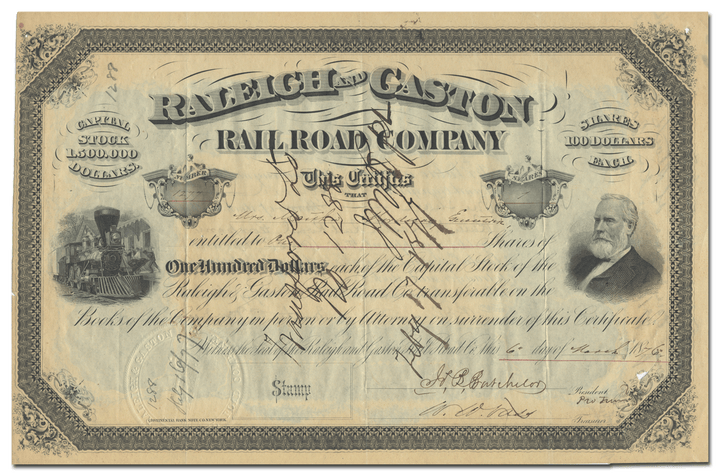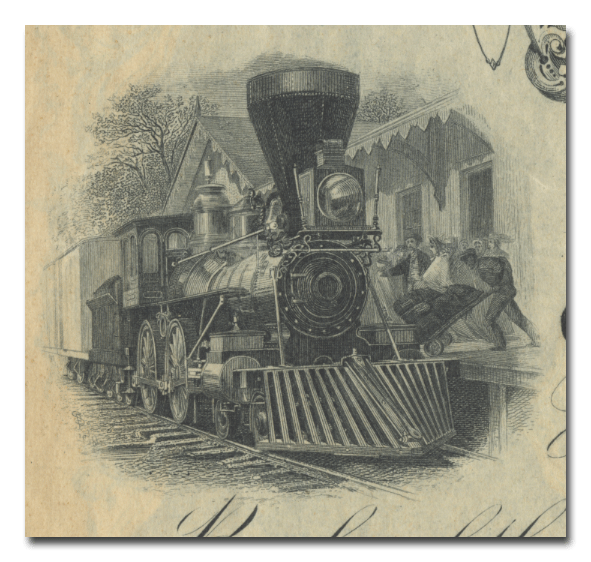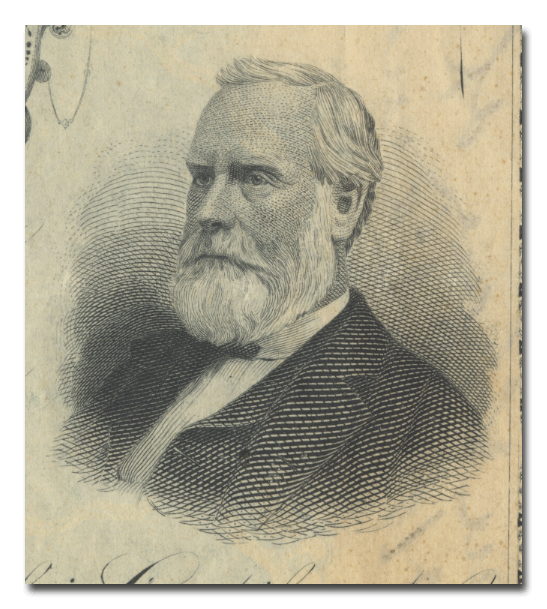Raleigh and Gaston Rail Road Company
- Guaranteed authentic document
- Orders over $75 ship FREE to U. S. addresses
Product Details
CompanyRaleigh and Gaston Rail Road Company
Certificate Type
Capital Stock
Date Issued
March 6, 1876
Canceled
Yes
Printer
Continental Bank Note Company
Signatures
Hand signed
Approximate Size
10 1/2" (w) x 7" (h)
Images
Show the exact certificate you will receive
Guaranteed Authentic
Yes
Additional Details
NA
Historical Context
The Raleigh and Gaston Railroad was a Raleigh, North Carolina-based railroad opened in April 1840 between Raleigh and the town of Gaston, North Carolina, on the Roanoke River. It was North Carolina's second railroad (the Wilmington and Raleigh Railroad opened one month earlier). The length was 100 miles and built with 4 ft 8 inch gauge.
The benefits of the Raleigh and Gaston line were apparent immediately. Soon after the line’s debut, local coaches began transporting goods to and from the main depot downtown. Other forms of transportation, such as steamboats and stagecoaches, would accommodate the trains’ arrival and departure times in their own schedules. The train allowed for quick transportation of goods, and also provided jobs for locals in Raleigh, as the Raleigh and Gaston line was widely known to “to give employment to native Southerners, in preference to reckless adventurers, either from the North or elsewhere.” Raleigh welcomed the promise of the iron horse with a three-day celebration heralded with cannons.
The Confederacy used the Raleigh and Gaston heavily towards the end of the Civil War, but years of contributing to the failed war effort took its toll on the Raleigh economy.
The Raleigh and Gaston Railroad merged with the Seaboard Air Line Railroad in 1900, eventually becoming part of CSX Transportation. The Raleigh and Gaston's tracks now make up part of CSX's S Line as the Norlina Subdivision of CSX's Florence Division.
The gentleman pictured at the right side of this piece is George Washington Mordecai.
Mordecai was a leader in railroad pioneering in North Carolina. He was a subscriber to and an incorporator of the Experimental Rail Road (1832–40) that hauled granite from a local quarry to Union Square for building the 1840 state capitol. He was an incorporator and first president (1836–40) of the Raleigh and Gaston Railroad (later Seaboard) and traveled to England on business for the company during the winter of 1838–39. After the state acquired the road, he was again an incorporator and served a second term as president in 1851–52 under the reorganization, remaining a director for the rest of his life. When the North Carolina Railroad was chartered in 1849, he was appointed a commissioner to create its capital stock and was himself the largest subscriber in the railroad, completed in 1856. He had aided in attempts to build a Raleigh and Columbia Railroad in the 1840s. At the outbreak of the Civil War, he was one of the commissioners who solicited subscriptions for the Chatham Railroad (later Raleigh and Augusta), which was designed to link Raleigh with the Chatham coal fields. A frequent delegate to internal improvements conventions in his own and adjoining states (1849–50 and 1856–57), he also solicited subscriptions for the Fayetteville and Northern Plank Road in 1851.
During the closing decades of the antebellum period, Mordecai was involved in the banking interests of the state. In 1849 he was elected president of the Bank of the State of North Carolina, succeeding his future father-in-law, Duncan Cameron, and in 1859 he also became president of the Bank of North Carolina. Marshall De Lancey Haywood noted that shortly before the surrender of the Confederacy in 1865, Mordecai converted into gold some $500,000 of the bank deposits, which he secreted from possible confiscation by Union forces and later prorated among the depositors to whom the funds belonged.
In 1833 he had established with his brother Augustus and James McKimmon the dry goods business of Mordecai and McKimmon. After 1838 the firm continued under McKimmon's name in a large brick commercial building constructed by Mordecai and Gavin Hogg in 1835 on the site of the burned Casso's Inn in Raleigh. He also served as vice-president of the North Carolina Mutual Insurance Company, chartered in 1849; as organizing chairman in 1858 and longtime director of the Raleigh Gas Company; and as president of the North Carolina branch of the DeSoto Insurance Company from its organization in 1869 until his death.
Related Collections
Additional Information
Certificates carry no value on any of today's financial indexes and no transfer of ownership is implied. All items offered are collectible in nature only. So, you can frame them, but you can't cash them in!
All of our pieces are original - we do not sell reproductions. If you ever find out that one of our pieces is not authentic, you may return it for a full refund of the purchase price and any associated shipping charges.






